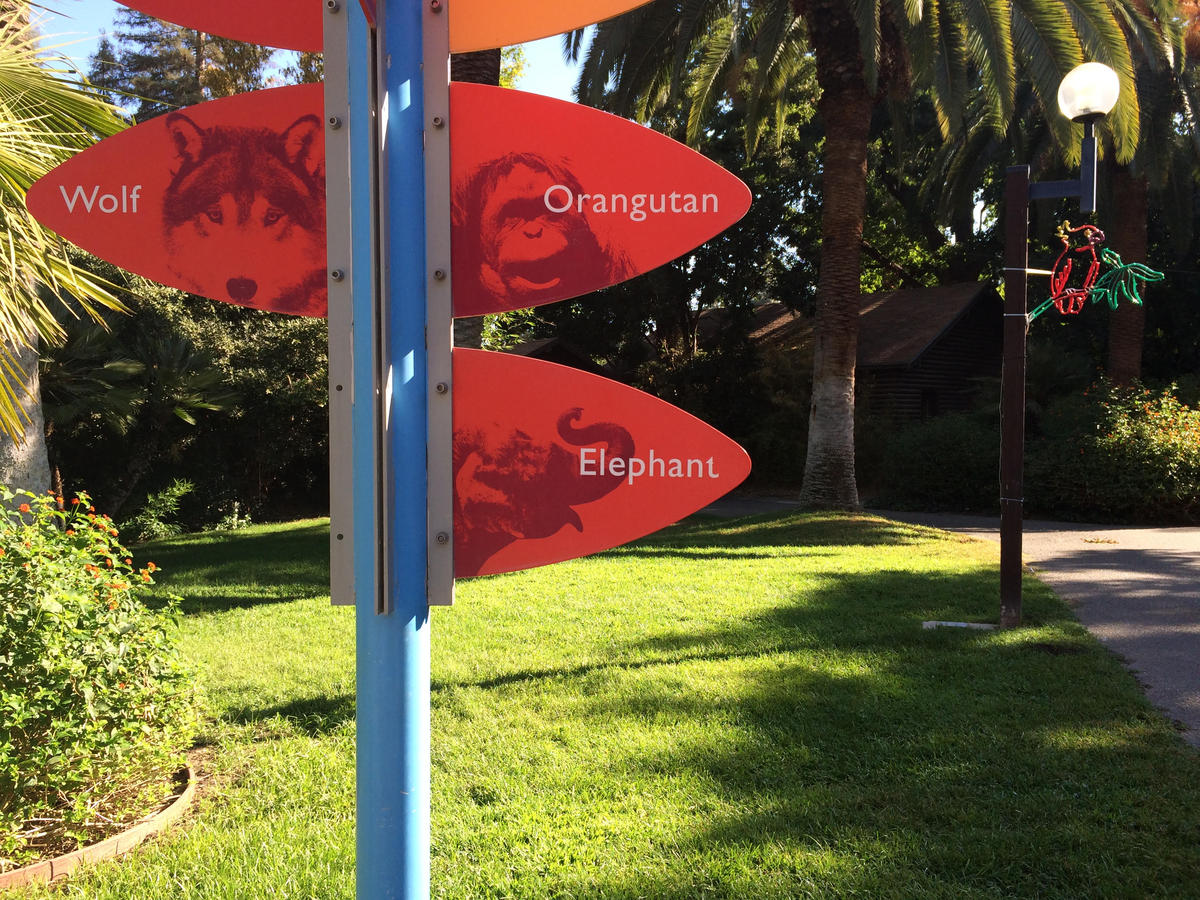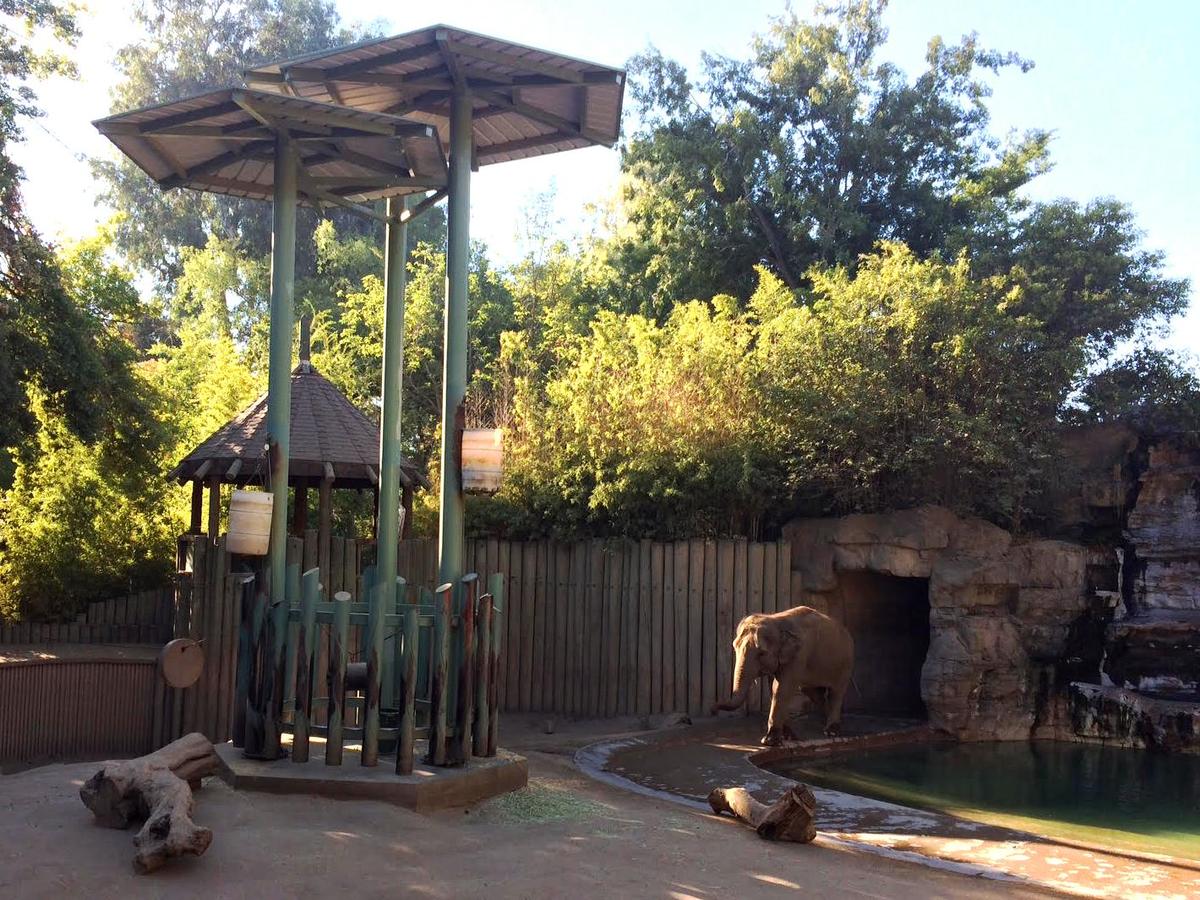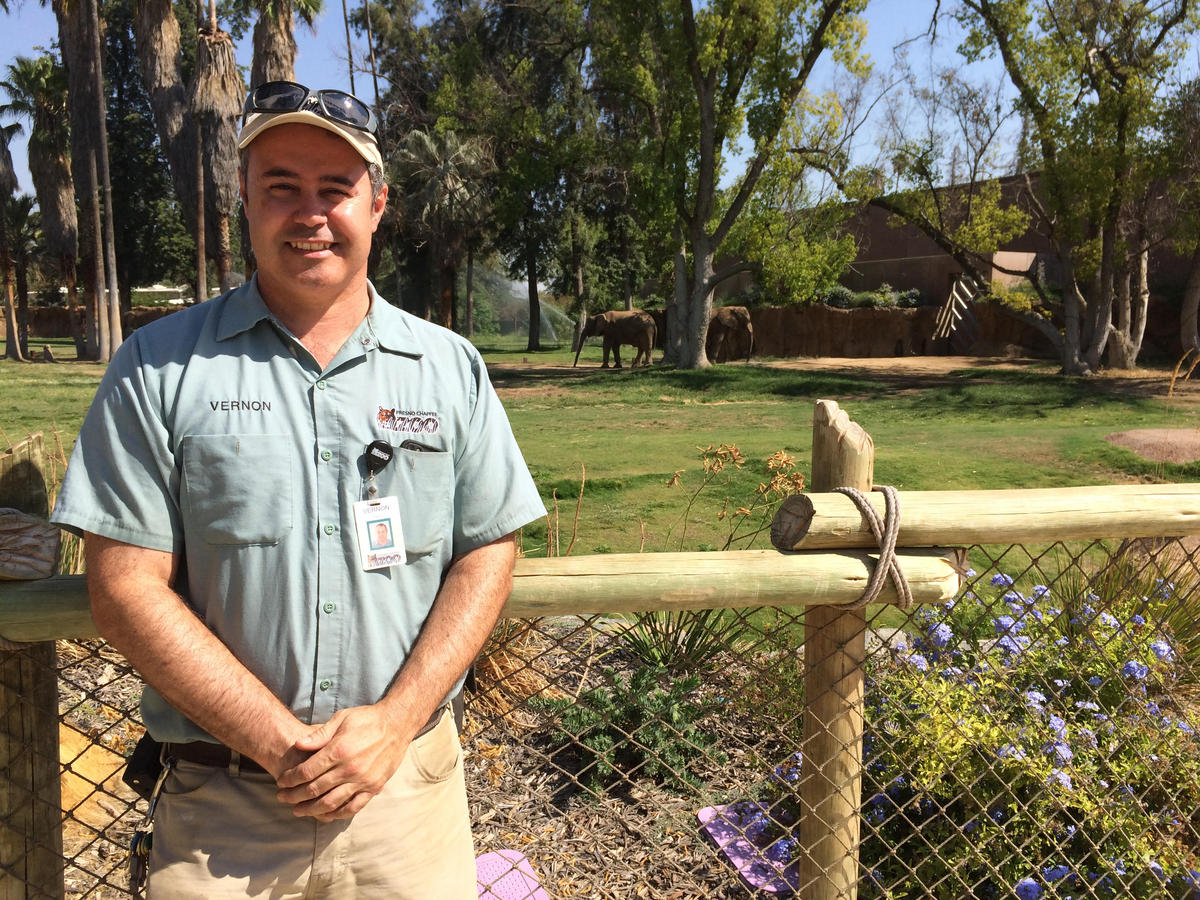- Here’s an interesting take on wildlife welfare. It demonstrates promising results and may have implications for other animal habitats.
-
African elephant Musi hangs out in the Fresno Chaffee Zoo’s new African Adventure exhibit. Credit: Fresno Chaffee Zoo
Fitness tracking is all the rage right now. If you want to, you can monitor your heart rate, count your footsteps and calories burned, and even monitor your sleep patterns, all using devices that can fit around your wrist or in your pocket. But that’s if you’re a human. Kerry Klein takes us to the Fresno Chaffee Zoo, where fitness tracking is moving to a whole new level.
Shaunzi used be a little overweight. But she got on an exercise routine and ditched the jelly beans for apples and carrots. She’s doing fine now; right around 6,000 pounds. She’s one of the Fresno Chaffee Zoo’s Asian elephants.

Credit: Kerry Klein/KVPR
Back in 2012, she wore a GPS tracker for a year as part of a multi-national research program. Now, lead elephant curator Vernon Presley tells me, that data is being used in another monitoring program to improve her and other elephants’ health. “We’ll get more concise information on body scoring, of how fit our elephants are,” he says, as well as “how much we time we spend with our elephants.”
Shaunzi, the zoo’s four other elephants and their caretakers are now a part of the Elephant Welfare Initiative, a collaborative effort across North America to apply scientific data directly toward improving elephant care. Using a new software system, caretakers each day log what their elephants do, and then receive a report card with suggestions on how to enhance their routine. The whole initiative aims to improve the health and welfare of captive elephants—a population known to suffer more from obesity, foot problems and reproductive complications than their wild counterparts. Fresno Chaffee Zoo is one of 20 or so early adopters of the program. “We really feel this is what they call a lifestyle change in the elephant community,” says Presley. “We have to now commit even a greater amount of resources into monitoring our elephants’ behavior and how well we’re taking care of them.”
The morning I visit the zoo, Shaunzi struts into her enclosure alongside the waterfall and heads straight to a network of chains and hanging objects. She reaches her trunk into a barrel above her head and shakes it until a cloud of hay rains down. It’s breakfast. She picks some off the ground and munches happily before reaching up again. Presley says she’s got a strategy. “If you had a box of M&Ms, you can pick one out at a time,” he says, “but if you pour the whole box of M&Ms out you can grab a whole handful and eat it.”

Asian elephant Shaunzi approaches a network of feeding structures. Research shows that varied feeding routines and methods are correlated with higher reproductive success. Credit: Kerry Klein/KVPR
Elephants enjoy working for their food. And new research says it’s good for them: for females, feeding challenges like this are actually correlated with better reproductive health. That’s the kind of data that the Elephant Welfare Initiative is based on.
Evidence-based animal care may sound obvious, but wide-reaching data on captive animal populations is actually pretty rare. Studies tend to examine only a small number of elephants, or only a limited set of welfare indicators.
Cheryl Meehan recognized this problem and wanted to do something about it. She’s the director of the AWARE Institute, a consulting organization that helps zoos improve their welfare practices. So in 2012, she worked with nearly 70 zoos to enroll over 250 elephants in an ambitious research program. That’s almost every elephant in every accredited zoo in North America. “It’s safe to say that this is the largest set of studies on zoo animal welfare that’s ever been conducted,” she says.

Curator of elephants and ungulates Vernon Presley stands in front of the elephant enclosure at the African Adventure exhibit. Credit: Kerry Klein/KVPR
For every one of those elephants, keepers strapped on GPS units, tracked vital signs, and analyzed foot and joint health. They collected blood and fecal samples, filled out detailed surveys about their elephants’ social groups, and some even monitored behaviors using video cameras.
The result was 10 research articles published earlier this summer in the journal PLOS One. As expected, Meehan and her fellow researchers found that enclosures with soft sand and grass promoted healthy feet and joints. More surprising, however, was that bigger enclosures didn’t seem correlated with healthier elephants. When it came to socialization, elephants with more social opportunities demonstrated more positive indicators—like higher daily walking distance—and fewer negative ones—like so-called stereotypic behavior, in which an elephant sways back and forth or repetitively swings its trunk. “By supporting a social environment where animals are spending larger amounts of time in larger, stable social groups,” Meehan says, “we are not only supporting their natural behavioral biology but also providing a reduction in the risk of the development of these abnormal behaviors.”
These quantitative connections are the foundation for the software system that gives feedback to participants in the initiative. “The metrics are basically automatically running and spitting out real-time information,” says Greg Vicino, an associate curator of elephants at San Diego Zoo Global and one of the initiative’s partners, “in this supercool-looking dashboard that said elephant manager or curator can sit at and look at and basically say, ‘okay, my social experience for the day was a 9 out of 10. What’s it going to take tomorrow for me to push that needle to a 10?’”
But not everyone is excited about this initiative and its parent research. Kate Dylewsky of the advocacy group Born Free USA says the PLOS One studies confirm that elephants don’t belong in zoos at all. “They showed that elephants in zoos only walk 5.3 kilometers a day, whereas in the wild, African elephants can walk over 50 miles a day,” she says. “There were 25 percent with joint problems, 67 percent with foot problems, and then a whole host of reproductive issues.”
Back at the Fresno Chaffee Zoo, Presley says elephant keepers are incorporating lessons learned from the research into their care. They’ve helped Shaunzi and fellow Asian elephant Kara each lose around 2,000 pounds. They’re varying the animals’ feeding habits. And they know their elephants would benefit from more social opportunities. Presley says they’re looking for a new home for Shaunzi and Kara so the two can mingle with a bigger herd of Asian elephants. As for the African elephants—Musi, Amy and Miss Betts—the zoo hopes they’ll create their own herd soon.
Story courtesy of Valley Public Radio in Central California.

